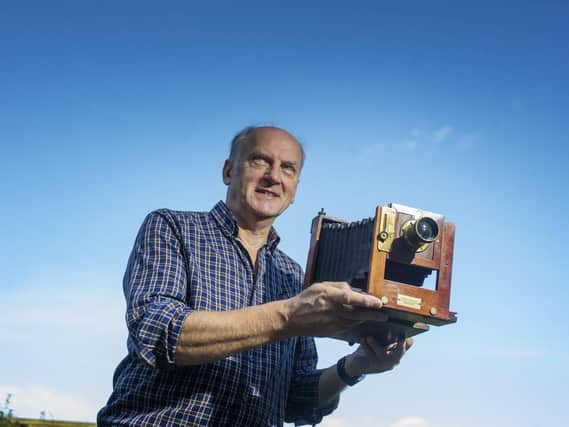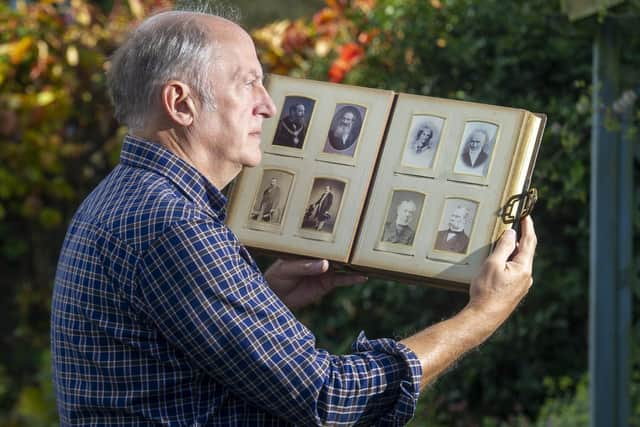How chance discovery of old picture album sparked Leeds man's fascination for Victorian photography


When retirement looms on the horizon, a lot of folk make plans. They might try to improve their golf handicap, learn to paraglide or join a dance class, perhaps? Steve Lightfoot admits that when his management career in IT was coming to an end he was looking for something interesting to do.
Like many of us, he enjoys a good old rummage around in bric-a-brac stores. After all, someone’s junk is nearly always another person’s treasure. However, Steve’s unexpected discovery has turned him into one of the leading experts on early photography, as well as being a skilled genealogist and something of a sleuth when it comes to digging out historic facts.
Advertisement
Hide AdAdvertisement
Hide Ad“I don’t know whether it has turned into an obsession, or a passion. Either way. It has been – and still is – a fascinating journey,” he says.


What Steve found was an old picture album, stuffed full of sepia photographs, which charted the history of one particular Bradford family. It had initially belonged to a Laura Massum, and when he asked the shop manager where he had found it, he was told it was from a house clearance.
“My curiosity started to fire up and as I turned over the pages I began to wonder who all these people were. They were of all ages and all sorts of things like weddings and christenings. And I found it so sad that they had, in effect, been consigned to the dustbin,” says Steve.
Whoever had lovingly placed them in the album had made the mistake that we nearly all make – they hadn’t written their names alongside the photos. Or the dates and places. “There was one thing that was on my side, however, and that was the surname, Massum. It’s not a common name, in fact it is rather unusual. If it had been a Smith, I’d have been stuck before I even started.”
Advertisement
Hide AdAdvertisement
Hide AdSteve managed to track down Laura’s descendants and then reunited them with the album, which they didn’t know even existed. It was the start of a quest for Steve, and his wife Andrea, based in Pudsey. This initial glimpse into the Victorian and Edwardian world of photography has led to him becoming something of an authority on the subject.
For a century and more ago, Bradford and Leeds seem to have been two of Britain’s centres of excellence. “Back then just about any town of significance had maybe 10 or 12 photographic studios on their high streets, but not Leeds and Bradford. In this relatively small geographic area there were simply hundreds of businesses, all set up in the years just after 1850,” says Steve. “In Bradford, there were so many that a lot of them were next door to each other.”
The first pictures to be taken in the town are reckoned to be from 1842, when a visiting studio set up in the Golden Lion Inn. “They were all in competition, but – by and large – it seemed to be quite a friendly rivalry,” adds Steve.
It was driven by a new “photo-mania”. People wanted their pictures taken. They wore their very best clothes and sat and posed for the occasion. The most popular results went on to things that were called “cartes de visite”, visiting cards with their own pictures, which they would pass on to family, friends and sweethearts.
Advertisement
Hide AdAdvertisement
Hide AdIn the beginning, the cartes were about 10/6 (55p) for a dozen, and you could order more if you wanted them, because a numbered record was kept of the sitter, so that more could be run off as and when required.
There was also a good market in selling “celebrity” images. In Haworth, there was a brisk trade in pictures of Charlotte Brontë and her father, the Rev Patrick Brontë, and it continued for long after both had died.
The studios were also part of a wider social change, since they employed a lot of young women. Back then if you were a lass from a working class family you almost inevitably went off to work in the local mill, or you might be lucky enough to get a position as a governess. Others became shop-girls.
“To work in a photographer’s studio offered a lot of opportunities,” says Steve. “You could be what today we would call a receptionist, or you might be trained to hand-colour the photographs. You could assist with making the scenery and props, you’d be useful in a lot of ways. In the directory of Bradford studios alone, there were a good handful of women who actually owned the premises and the business, which was truly ground-breaking for the time.”
Advertisement
Hide AdAdvertisement
Hide AdAmong the photographers were some very enquiring minds, eager to develop and exploit the new technology at their fingertips. They looked at fresh ways of printing their photographs, and how to prevent fading.
One of the most incredible stories came out of a city centre studio where, only months after Wilhelm Rontgen had announced his discovery of X-rays to an astonished world in 1895, a service was set up to supply these amazing new views of injuries to the body’s bone structure to Bradford doctors, medics and police. It was an extraordinary leap forward.
Equally as enterprising was another photographer fascinated by the potential of the moving image. On June 19, 1887, he got on a train to London and stayed overnight before setting up his camera to film the procession for Queen Victoria’s Golden Jubilee the following day. Having got his images, he made his way back to King’s Cross, and into a specially chartered and converted carriage – a mobile studio, in effect – where the film was processed as he returned north.
By the time the train pulled into Bradford, there was a film to be exhibited. And so, on the same evening that the Queen, her family and no less than 50 of the crowned heads and princes of European royalty were sitting down to toast the elderly monarch’s continued good health, the Bradford public were able to see their sovereign in her carriage – not in a cinema, but on to the wall of a building in the city centre. “If that isn’t Yorkshire enterprise,” says Steve, with a chuckle, “I don’t know what is.”
Advertisement
Hide AdAdvertisement
Hide AdSome photographers – like Oliver Sarony – set up shop away from industrial West Yorkshire. Sarony established a huge reputation for his purpose-built studio on South Cliff in Scarborough, which flourished from 1858 onwards in what is now St Martin’s Avenue (he also kept his studios in Leeds). The cream of society turned up on a daily basis. “If there’s one thing that characterises all of them, it’s that they were all showmen, a little on the flamboyant side, and larger than life,” adds Steve.
He now has a vast – so many that he is unable to count them – and enviable collection of pictures, many in complete albums, others as single shots, but each of which sheds a little more information on the social history of the period.
Steve is also a font of stories and an encyclopaedia of photographic facts. He and his wife continue their quest for photographic gems from the past.
“I think that the saddest thing is that most of these people you see looking back at you are almost totally forgotten,” he says. “But each of them, whatever their place in life may have been, has a tale to tell. They are individuals. I can’t tell you how much pleasure it is to be able to help in revealing their stories.”